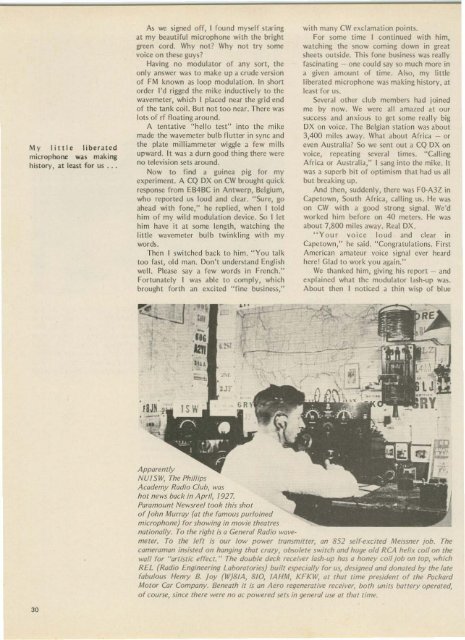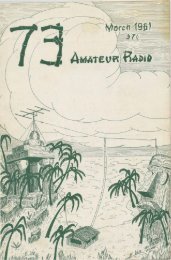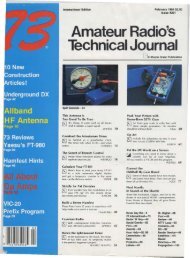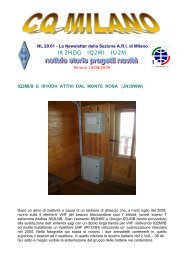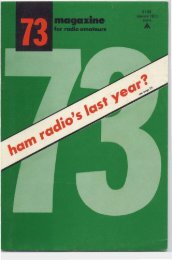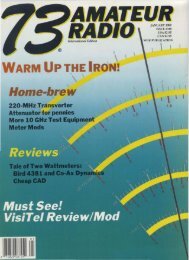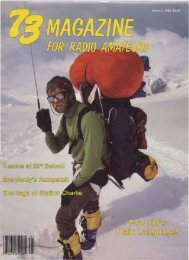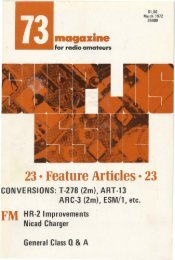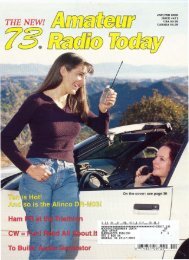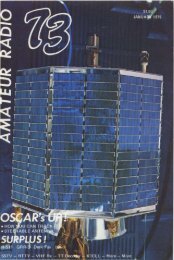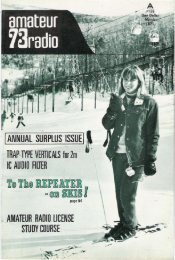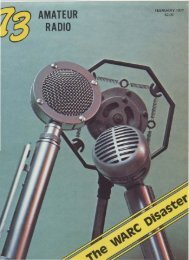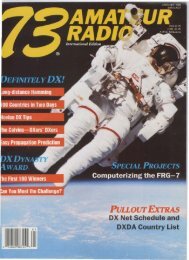IN THIS ISSUE -- NEW Magazine Formats! NEW FCC Regs Corning ...
IN THIS ISSUE -- NEW Magazine Formats! NEW FCC Regs Corning ...
IN THIS ISSUE -- NEW Magazine Formats! NEW FCC Regs Corning ...
Create successful ePaper yourself
Turn your PDF publications into a flip-book with our unique Google optimized e-Paper software.
My little liberated<br />
microphone ...as making<br />
history, at least for us . ..<br />
30<br />
As '¥'IC signed off, I found myself staring<br />
at my beautiful microphone with the bright<br />
green cord. Why not? Why not try some<br />
voice on these guys ?<br />
Having no modulator of any sort, the<br />
o nly answer was to make up a crude version<br />
of FM known as loop modulation. In short<br />
order I'd rigged the mike inductively to the<br />
wavcmcter, whi ch I placed ncar the grid end<br />
of the tank coil. But not too ncar. There was<br />
lots of rf floating around.<br />
A tentative " hell o test" into the mike<br />
made the wavemctcr bulb fl utter in sync and<br />
the plate milliammeter wi ggle a few mills<br />
upward. It was a durn good thing there were<br />
no television sets around.<br />
Now to fi nd a guinea pig for my<br />
experiment. A CQ DX on CW brought quick<br />
response from EB4BC in Antwe rp, Belgium,<br />
who reported us loud and clear. "Sure, go<br />
ahead with fane," he replied, when I told<br />
him of my wi ld modulation device. So I let<br />
him have it at some length, watching the<br />
li ttle wavcmcter bulb twinkl ing with my<br />
words.<br />
Then I switc hed back to him. " You ta lk<br />
too fast, old man. Don 't understand English<br />
well. Please say a few words in French ."<br />
Fortunately I was able to comply, which<br />
brought for th an excited "fine business,"<br />
...<br />
•<br />
•<br />
fSJ!<br />
I<br />
,<br />
I<br />
/<br />
wi th many CW exclamation points.<br />
For some time I continued with him ,<br />
watching the snow coming down in great<br />
sheets outside. This fone business was really<br />
fascinating - one could say so much more in<br />
a given amount of time. Also, my little<br />
libe rated mi crophone was making history, at<br />
least for us.<br />
Several other club members had joi ned<br />
me by now. We were all amazed at our<br />
success and anxious to get some really big<br />
DX on voice. The Belgi an sta tion was about<br />
3,400 miles away. What about Africa - or<br />
even Australia? So we sent out a CQ DX on<br />
voice, repeating several times. "Calling<br />
Africa or Australia," I sang into the mi ke. It<br />
was a superb bit of optimism that had us all<br />
but breaking up.<br />
And then, suddenly, there was FD-A3Z in<br />
Capetown, South Africa, calling us. He was<br />
on CW with a good strong signal. We 'd<br />
worked him before on 40 meters. He was<br />
about 7,800 miles away. Real DX.<br />
" You r voice lo ud and clear in<br />
Capetown," he said. "Congratulatio ns. First<br />
American amateur voice signal ever heard<br />
here! Glad to work yo u again."<br />
We than ked him, giving hi s report - and<br />
explained what the modulator lash-up was.<br />
About then t noticed a thin wisp of blue<br />
Apparently<br />
NU1S W, The Phillips<br />
Academy Radio Club, was<br />
hot news back in April, 1927.<br />
Param ount Newsreel took this shot<br />
ofjohn Murray (at the famous purloined<br />
microphone) for showing in movie theatres<br />
nationally. To the right is a General Radio WOllt'meter.<br />
To the left is our low power transmitter, an 852 self-excited Meissner job. The<br />
cam eraman insisted on hanging that crazy, obsolete switch and huge old RCA helix coil on the<br />
"Wall for "artistic effect. " The double deck receiver lash-up has a honey coil job on top, which<br />
REL (Radio Engineering Laboratories) built especially for us, designed and donated by the late<br />
fabulous Henry B. j oy ( W)8 IA, 810, IAHM, KFKIV, at that time president of the Packard<br />
Motor Car Company. Beneath it is an Aero regenerative receiver, both units battery operated,<br />
ofcourse, since there were no oc powered sets in general use at that time.<br />
-<br />
•


